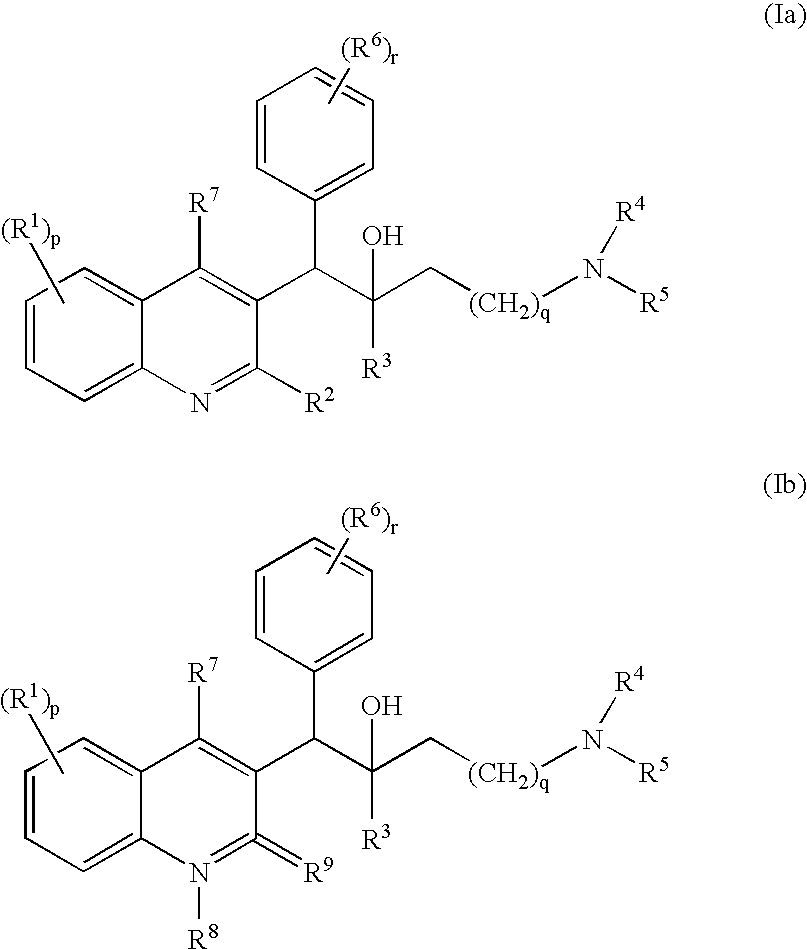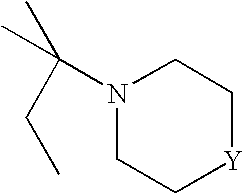Mycobacterial inhibitors
a technology of mycobacterial bacteria and inhibitors, applied in the direction of antibacterial agents, drug compositions, biocides, etc., can solve the problems of insufficient treatment, no single agent that is effective in clinical treatment, and lethal mdr-tb, and achieve the effect of inhibiting the growth of bacterial microorganisms
- Summary
- Abstract
- Description
- Claims
- Application Information
AI Technical Summary
Benefits of technology
Problems solved by technology
Method used
Image
Examples
example a1
[0118]
[0119]Benzenepropanoylchloride (0.488 mol) was added dropwise at room temperature to a solution of 4-bromobenzenamine (0.407 mol) in Et3N (70 ml) and CH2Cl2 (700 ml) and the mixture was stirred at room temperature overnight. The mixture was poured out into water and concentrated NH4OH, and extracted with CH2Cl2. The organic layer was dried (MgSO4), filtered, and the solvent was evaporated. The residue was crystallized from diethyl ether. The residue (119.67 g) was taken up in CH2Cl2 and washed with HCl 1N. The organic layer was dried (MgSO4), filtered, and the solvent was evaporated. Yielding: 107.67 g of intermediate compound 1.
[0120]
[0121]Accordingly, intermediate compound 9 was prepared in the same way as intermediate compound 1 but using 4-methyl-benzenepropanoylchloride.
example a2
[0122]
[0123]The reaction was carried out twice. POCl3 (1.225 mol) was added dropwise at 10° C. to DMF (0.525 mol). Then intermediate compound 1 (prepared according A1) (0.175 mol) was added at room temperature. The mixture was stirred overnight at 80° C., poured out on ice and extracted with CH2Cl2. The organic layer was dried (MgSO4), filtered, and the solvent was evaporated. The product was used without further purification. Yielding: (77.62 g; Yield=67%).
[0124]
[0125]Accordingly, intermediate compound 10 was prepared in the same way as intermediate compound 2, starting from intermediate compound 9 (prepared according to A1).
example a3
[0126]
[0127]A mixture of intermediate compound 2 (prepared according to A2) (0.233 mol) in CH3ONa (30%) in methanol (222.32 ml) and methanol (776 ml) was stirred and refluxed overnight, then poured out on ice and extracted with CH2Cl2. The organic layer was separated, dried (MgSO4), filtered and the solvent was evaporated. The residue was purified by column chromatography over silica gel (eluent: CH2Cl2 / cyclohexane 20 / 80 and then 100 / 0; 20-45 μm). The pure fractions were collected and the solvent was evaporated. Yielding: 25 g of intermediate compound 3 (Yield=33%; mp. 84° C.) as a white powder.
[0128]
[0129]Accordingly, intermediate compound 11 was prepared in the same way as intermediate compound 3, starting from intermediate compound 10 (prepared according to A2).
PUM
| Property | Measurement | Unit |
|---|---|---|
| melting point | aaaaa | aaaaa |
| concentration | aaaaa | aaaaa |
| body weight | aaaaa | aaaaa |
Abstract
Description
Claims
Application Information
 Login to View More
Login to View More - R&D
- Intellectual Property
- Life Sciences
- Materials
- Tech Scout
- Unparalleled Data Quality
- Higher Quality Content
- 60% Fewer Hallucinations
Browse by: Latest US Patents, China's latest patents, Technical Efficacy Thesaurus, Application Domain, Technology Topic, Popular Technical Reports.
© 2025 PatSnap. All rights reserved.Legal|Privacy policy|Modern Slavery Act Transparency Statement|Sitemap|About US| Contact US: help@patsnap.com



